
The oyster effect
February 23, 2024
By Lynn Fantom
NOAA develops new tool to measure the eco impact of oyster cages.
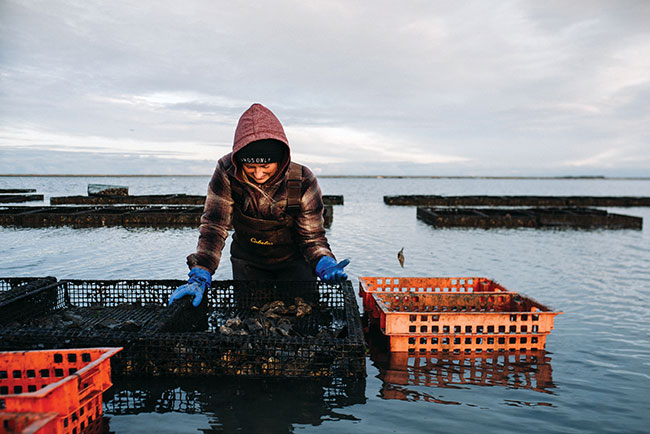 A new tool from NOAA utilizes values from waterbodies with oyster aquaculture, including Island Creek Oysters shown here.
Photos: Sean Maiorano, Island Creek Oysters
A new tool from NOAA utilizes values from waterbodies with oyster aquaculture, including Island Creek Oysters shown here.
Photos: Sean Maiorano, Island Creek Oysters Before they show up on tables raw, fried, roasted, or stewed, oysters clean the water where they grow. Their cages attract fish and provide habitat.
Now some of these valuable ecosystem services can be easily and reliably quantified through a new tool that will help regulators make science-based decisions about if and where to issue farm permits.
The National Oceanic and Atmospheric Administration (NOAA) demonstrated the beta version of the tool’s first module that targets nitrogen removal at the Northeast Aquaculture Conference and Expo in Providence, R.I. in January and the Aquaculture America 2024 conference in San Antonio, Texas, in February. With funding from the NOAA Office of Aquaculture, the project represents diverse collaborators from North Carolina to Maine and drew positive feedback.
“I really like the very deliberate way it is targeted to address regulators who are experiencing public pushback,” said Boze Hancock, a senior marine habitat restoration scientist at The Nature Conservancy (TNC), who joined the audience in Providence. “Tools like these are only valuable if they are used.”
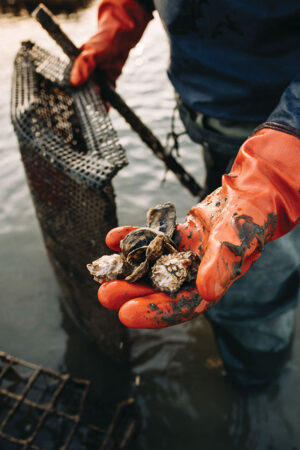
Oyster farming provides ecosystem services, including nitrogen and phosphorus removal, water filtration, and creation of fish habitat. (Photo: Sean Maiorano, Island Creek Oysters)
“I firmly believe that having this kind of data is very valuable to growers,” added Bob Rheault, executive director of the East Coast Shellfish Growers Association (ECSGA), which represents over 1,500 shellfish farmers from Maine to Florida.
Data at the fingertips
The tool synthesizes data collected by top regional scientists to create a robust prediction of how much nitrogen the harvest of Eastern oysters removes. It has similarities to the calculator developed by The Nature Conservancy (TNC) for restored oyster reefs but was designed specifically for oyster aquaculture.
TNC’s tool, in fact, provided the impetus. During discussions with TNC partners at the global environmental nonprofit’s aquaculture team retreat in 2022, Chris Schillaci of NOAA’s National Centers for Coastal Ocean Science (NCCOS) and Julie Rose of NOAA Fisheries Milford Lab hit upon the idea of tapping into East Coast data sources to power a new calculator for aquaculture.
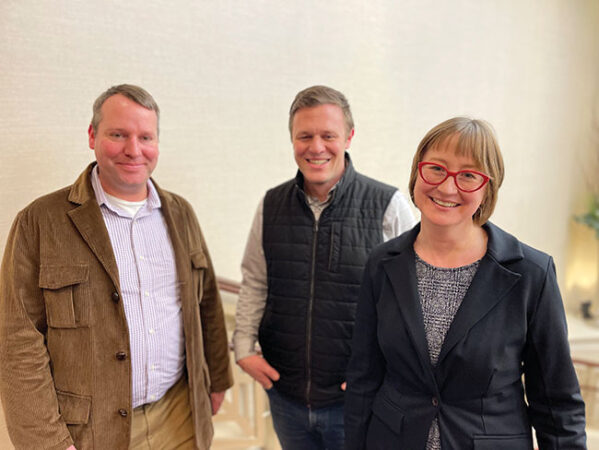
The year-long NOAA project to create an easy-to-use, reliable calculator to quantify the ecosystem benefits of oyster aquaculture was spearheaded by (L to R) Ryan Morse, Chris Schillaci, and Julie Rose. Photo: Lynn Fantom
As work began, the team applied methodology used by the Chesapeake Bay Program, which quantified the concentration of nitrogen in an oyster’s tissue and shell, as well as a prediction of dry weight based on harvest length.
In order for both growers and regulators to have confidence in the calculator’s output, all of the data came from waterbodies with oyster aquaculture, said Rose. The contributors included Cape Cod Cooperative Extension, Environmental Protection Agency (EPA) Narragansett, NOAA Milford, Rutgers University, Stony Brook University, University of Maine, University of New Hampshire, and University of North Carolina Wilmington.
“We were very fortunate to work with some very generous scientists across the region,” Rose added.
For programming and data analysis, NOAA Fisheries turned to oceanographer Ryan Morse. “The most time-consuming aspect of the project has been compiling data and conducting quality checks,” he said.
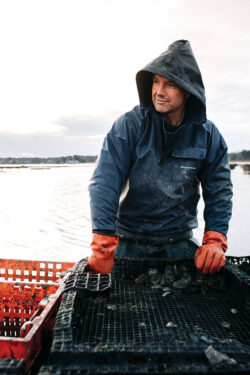
Oyster farming provides ecosystem services, including nitrogen and phosphorus removal, water filtration, and creation of fish habitat.
Photo: Sean Maiorano, Island Creek Oysters
Countering opposition and delays
The value of oysters produced by U.S. growers was US$285 million in 2018, up almost 60 percent from five years prior, according to the 2018 Census of Aquaculture from the United States Department of Agriculture (USDA). The 2023 census is due to be released in December.
With the start of new farms and expansion of others, “aquaculture permitting will definitely get tougher as space fills up,” Schillaci noted. Already some permit seekers are forced into less-than-desirable sites.
In addition, public pushback against aquaculture has increased despite its rising economic value and contribution to U.S. food production. “Right now, the social license to farm is our biggest challenge,” said Rheault, who has led ECSGA since 2008.
Lawyers are specializing in anti-aquaculture litigation. Property owners sue regulatory agencies, which can cause multi-year delays for the growers seeking permits. In Virginia, regulators are following up to ensure that people who have acquired leases are making efforts to propagate shellfish, and not doing so, for example, simply to keep farmers out.
Yet in the face of such opposition, “the ecosystem services [provided by oysters] are rarely considered in permit application materials and the environmental reviews by permitting agencies,” Schillaci said.
One of Schillaci’s tasks during the project was to confer widely with state and federal resource managers to find ways the current permitting process could accommodate consideration of shellfish ecosystem services. Among them was the Army Corps of Engineers, whose mandate is to weigh both adverse and beneficial factors in its public interest review.
A tool like this can support them with data – plus give “confidence in the numbers,” Schillaci said. “It can make tough decisions a little bit easier because they have information to support them.”
Easy-to-use, reliable, free
“We’ve heard from both regulators and industry members that they need a simple, intuitive way to calculate environmental benefits that are provided by shellfish aquaculture,” said Rose. The new tool was created with both groups of end users in mind.
The beta version of the nitrogen removal module requires only two inputs: the number of oysters for harvest and their size. It generates a map, with the latitudes and longitudes of the farm’s location. In addition to the numeric value (pounds of nitrogen permanently removed), the output includes text featuring proper technical language and citations, which would be easy for a regulator, for example, to copy and paste into the public review memo.
Following the conferences, the team has been incorporating feedback so that the tool, methodology, and data sources can be reviewed by NOAA and peers for scientific publication.
“The tool will be hosted on a NOAA website and will be freely available to the public,” added Kristen Jabanoski, science communications specialist at NOAA Fisheries. The team will partner with the Sea Grant extension community to continue to get feedback from shellfish growers and resource managers after it is launched.
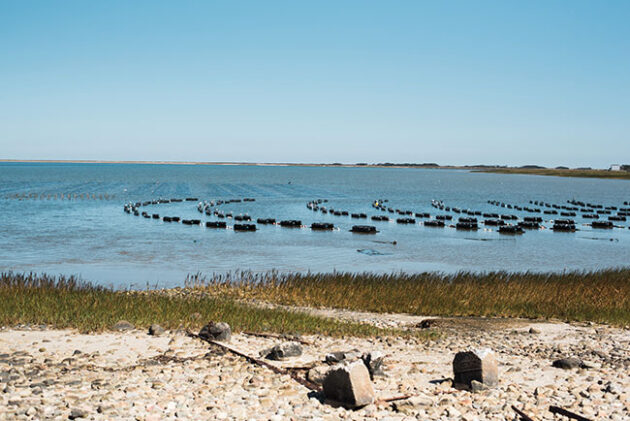
Island Creek Oysters in Duxbury, Mass., was one of the shellfish producers collaborating with marine scientists who took water samples for analysis. (Photo: Emily Hagen, Island Creek Oysters)
Flexibility for enhancements
With the core calculator now built, the team is looking toward future enhancements. Those may include phosphorus removal (when data gaps are resolved) and water filtration.
“We have a flexible tool that can be adapted when new data become available,” Rose said.
Region or state-specific values might also at some point be generated if data can support this function. If major differences are seen in gear or ploidy, the tool could also provide an option to select for those. Such enhancements depend on the availability of such granular data and also the judgment as to whether the differentials warrant greater complexity in the tool itself.
“We think that that median value may often make the most sense and doesn’t overpromise or underpromise in a significant way,” Schillaci said.
How oyster cages create essential fish habitat is another module on the horizon. In partnership with NOAA’s Northwest Fisheries Science Center, this module could be used in both the Northeast and Northwest. It will leverage recent data collected on oyster farms by NOAA teams on both coasts.
Since 2017, for example, Milford scientists in Connecticut have been studying how two commonly used styles of oyster cages function as fish habitat compared to naturally occurring rock reef. Using GoPro cameras, AI programs, and DNA analysis of scale and tissue deposits in water samples, they have learned about the abundance and behavior of fish such as black sea bass, cunner, scup, and tautog.
“We also see an opportunity to extend the tool beyond oysters to other commonly farmed shellfish, such as clams and mussels,” Schillaci added.
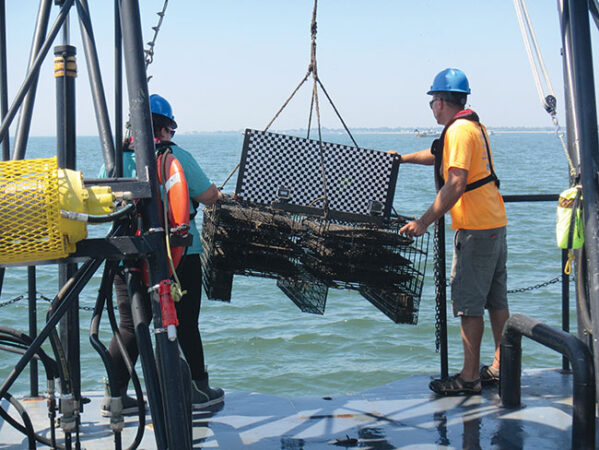
After fitting an oyster cage with two GoPro cameras, a NOAA Fisheries team returns it to the bottom of Long Island Sound at a Connecticut shellfish farm. (Photo: Renee Mercaldo-Allen, NOAA Federal)
Future opportunities
Maryland is the first state to have a program of nutrient credit trading. Launched via legislation in 2018, it helps address water quality issues in the Chesapeake Bay, such as excess nitrogen and phosphorus. Oyster farmers can sell the credits they create based upon the number and size of oysters they harvest.
As more states join Maryland in providing such trading credits, the new tool from NOAA may find additional relevance.
Mitigation is also being used more in aquaculture permitting, according to Schillaci. If a desired site overlaps with a resource area, a grower may opt to pay into a mitigation bank. But instead of paying three times the amount that is impacted, for example, more favorable ratios might be negotiated if the grower has been able to demonstrate the ecological value of the proposed farm.
All of this lies ahead as states nationwide grapple with water quality and biodiversity challenges, and greater recognition emerges of how shellfish aquaculture can help address them.
But for right now, Bob Rheault says, “I would rather get the ‘perception’ credit. I want to be able to stand up on a soap box and say ‘I don’t want a fraction of a penny.’ Instead, I want to say ‘I’m good for the environment and all you naysayers should be cheering us on.’”
Advertisement
- Aquaculture America 2024: Soft skills are invaluable to employers
- Atarraya’s Shrimpbox wins the Edison Awards





